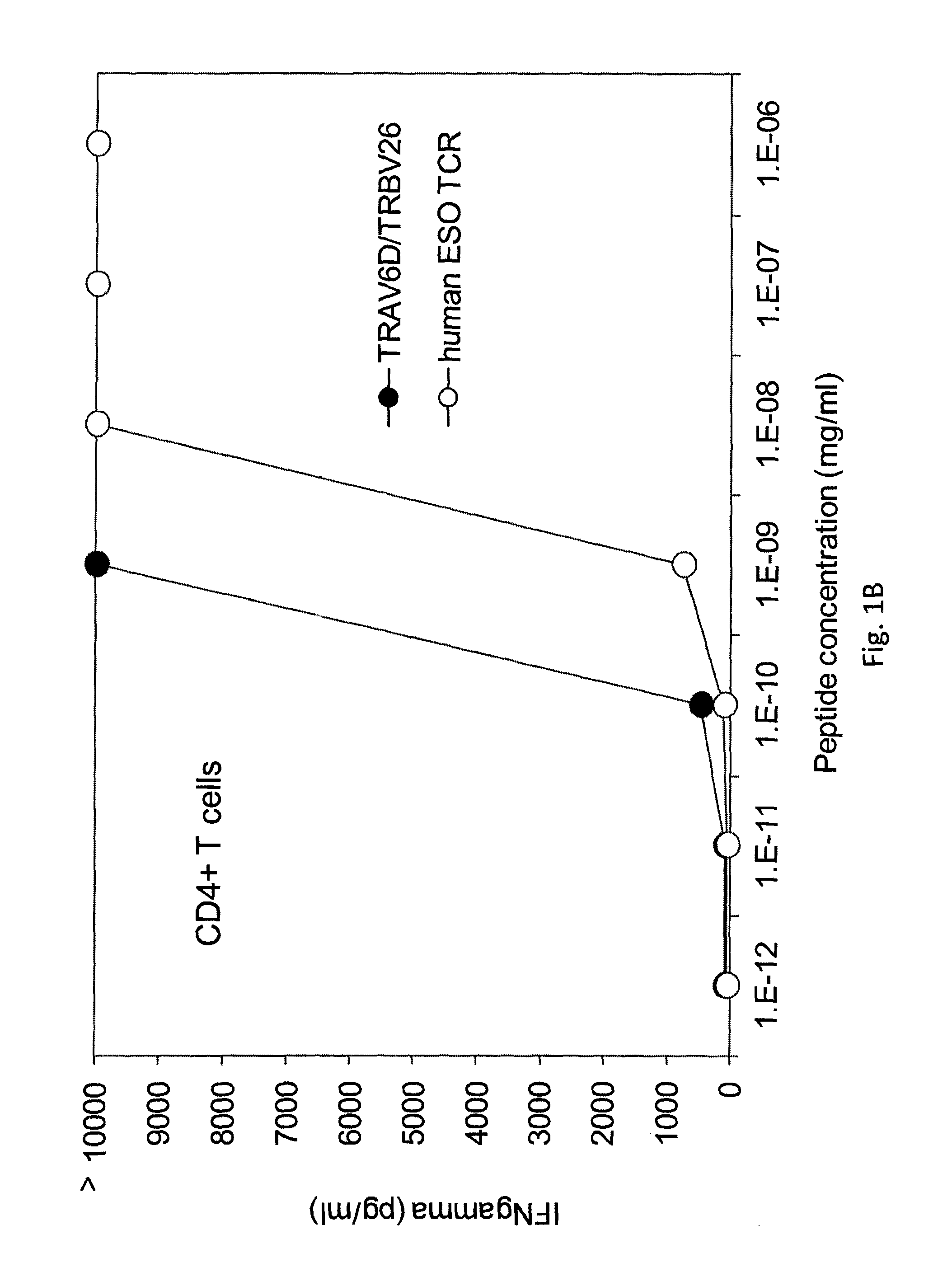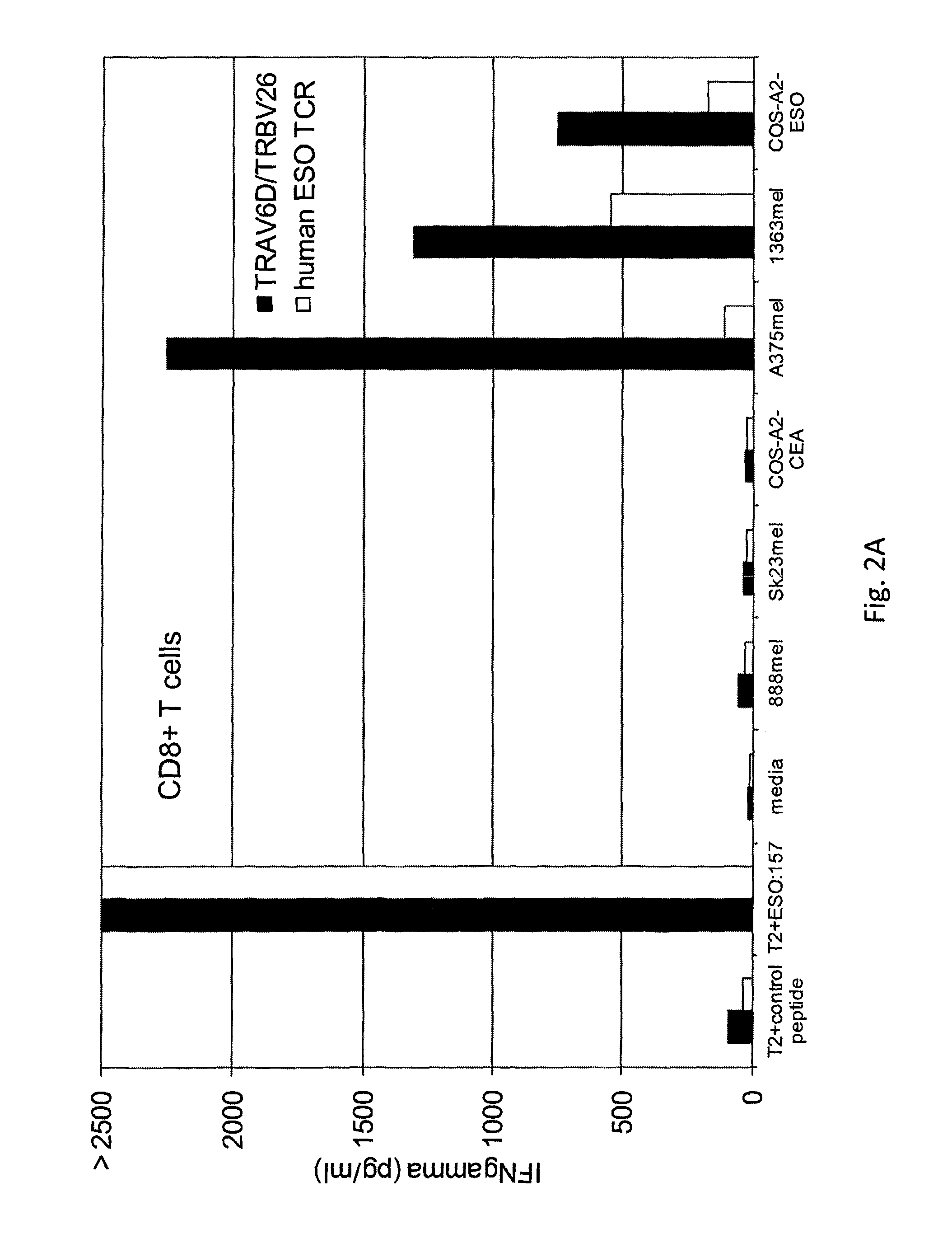Murine anti-NY-ESO-1 T cell receptors
a t cell receptor and murine technology, applied in the field of murine anti-ny-eso-1 t cell receptors, can solve the problems of many patients not having tumors, difficult to generate tumor-reactive t-cells from non-melanoma cancers, and still exist obstacles to the overall success of adoptive cell therapy
- Summary
- Abstract
- Description
- Claims
- Application Information
AI Technical Summary
Benefits of technology
Problems solved by technology
Method used
Image
Examples
example 1
[0101]This example demonstrates the identification of murine anti-NY-ESO-1 T cell clones.
[0102]HLA-A2 transgenic mice were immunized with 100 μg of peptide (NY-ESO-1157-165) and 120 μg of helper peptide (hepatitis B virus core peptide (HBVc):128-140) in 100 μl Incomplete Freund's adjuvant (IFA) subcutaneously (s.c.) at the base of the tail (50 μg of NY-ESO-1157-165 peptide on each of two sides of the tail), followed by a boost one week later with the same immunization.
[0103]Day 0: One week after the second immunization, splenocytes were harvested and stimulated in vitro with one of the following: (i) LPS-activated HLA-A2+ splenocytes (3,000 rads) (“LPS blast”) pulsed with 1 μg / ml priming peptide and 10 μg / ml human β2-microgobulin or (ii) T2 cells (17,000 rads) pulsed with 1, 0.1 or 0.01 μg / ml peptide.
[0104]Day 7: Bulk cultures were evaluated for specific reactivity via IFNγ secretion upon co-culture with one of the tumor cell lines set forth in Table 1. The results are shown in Tabl...
example 2
[0112]This example demonstrates the identification of murine anti-NY-ESO-1 T cell clones.
[0113]HLA-A2 transgenic mice were immunized and the splenocytes were harvested, stimulated, and evaluated for specific reactivity as described in Example 1.
[0114]Day 11: The bulk cultures were restimulated in 24-well plates under the following conditions: (i) irradiated T2 cells (18,000 rads) pulsed with 1, 0.1, or 0.01 μg / ml peptide: 4×105 cells / well; (ii) irradiated C57BL / 6 splenocyte feeders (3,000 rads): 1×106 cells / well; and (iii) 10 CU / ml IL-2.
[0115]Day 19: The bulk cultures (post two stimulations) were evaluated for specific reactivity via IFN-γ secretion upon co-culture with the tumor cell lines set forth in Table 3. Tumor cells were treated with IFNγ (20 ng / ml) and tumor necrosis factor alpha (3 ng / ml) overnight prior to the assay. The results are shown in Table 3 (IFN-γ (pg / ml)).
[0116]
TABLE 3RNAPost 2 bulk stims.NY-copies perLPS blasts +T2 + 0.1T2 + 0.01HLA-ESO-GAPDH1 μg / mlT2 + 1 μg / ml...
example 3
[0125]This example demonstrates the isolation of a murine anti-NY-ESO-1 TCR and the specific reactivity of the isolated TCR against NY-ESO-1.
[0126]The TCR from five clones, (namely, clones B, H, 5, 6, 1, 50, and 63) were isolated. The nucleotide sequence (RNA) encoding the TCR of each clone was isolated, sequenced, and transfected into human peripheral blood mononuclear cells (PBMC) from Patients 1 and 2. The transfected cells were stimulated with OKT3 and IL-2 and cultured alone (media) or co-cultured with T2 cells pulsed with control (HBV) peptide, T2 cells pulsed with NY-ESO-1157-165 peptide, COA-A2-CEA (NY-ESO-1−), COS-A2-ESO (NY-ESO-1+), or one of various melanoma tumor cell lines 888mel (NY-ESO-1−), Sk23mel (NY-ESO-1−), A375mel (NY-ESO-1+), 1363mel (NY-ESO-1+), 1390 (NY-ESO-1+), or 624 (NY-ESO-1+). IFNγ secretion was measured. The results are shown in Table 6 (IFNγ (pg / ml)).
[0127]
TABLE 6T2 + ESO:COS-COS-A2-T2 + HBV157media888Sk2313631390A375624A2-CEAESOHLA-A2−−−−+++++++NY-ESO-...
PUM
| Property | Measurement | Unit |
|---|---|---|
| temperatures | aaaaa | aaaaa |
| time | aaaaa | aaaaa |
| concentrations | aaaaa | aaaaa |
Abstract
Description
Claims
Application Information
 Login to View More
Login to View More - R&D
- Intellectual Property
- Life Sciences
- Materials
- Tech Scout
- Unparalleled Data Quality
- Higher Quality Content
- 60% Fewer Hallucinations
Browse by: Latest US Patents, China's latest patents, Technical Efficacy Thesaurus, Application Domain, Technology Topic, Popular Technical Reports.
© 2025 PatSnap. All rights reserved.Legal|Privacy policy|Modern Slavery Act Transparency Statement|Sitemap|About US| Contact US: help@patsnap.com



